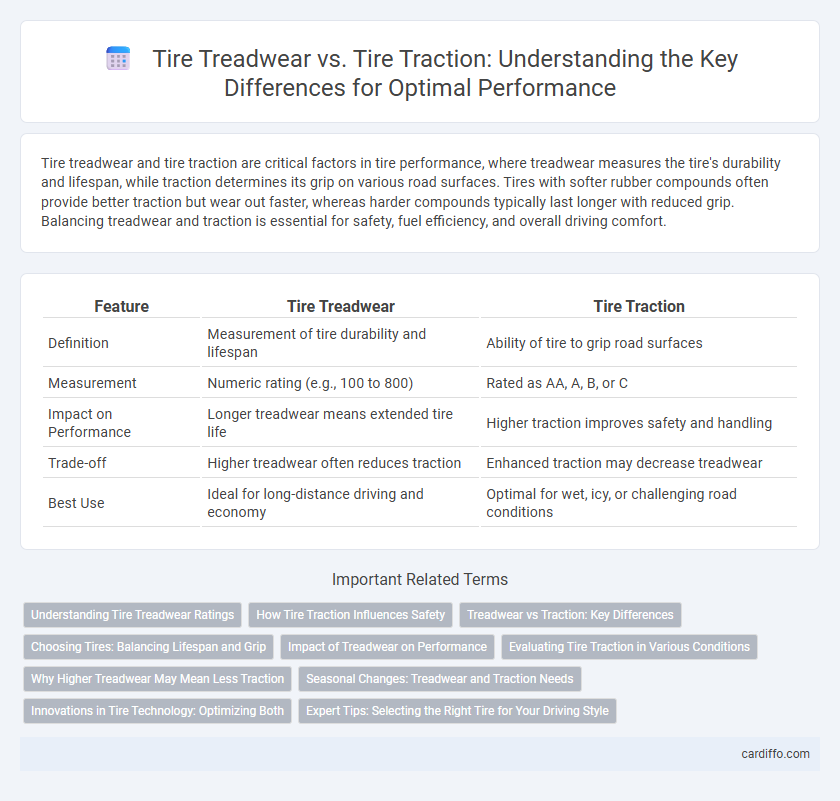Tire treadwear and tire traction are critical factors in tire performance, where treadwear measures the tire's durability and lifespan, while traction determines its grip on various road surfaces. Tires with softer rubber compounds often provide better traction but wear out faster, whereas harder compounds typically last longer with reduced grip. Balancing treadwear and traction is essential for safety, fuel efficiency, and overall driving comfort.
Table of Comparison
| Feature | Tire Treadwear | Tire Traction |
|---|---|---|
| Definition | Measurement of tire durability and lifespan | Ability of tire to grip road surfaces |
| Measurement | Numeric rating (e.g., 100 to 800) | Rated as AA, A, B, or C |
| Impact on Performance | Longer treadwear means extended tire life | Higher traction improves safety and handling |
| Trade-off | Higher treadwear often reduces traction | Enhanced traction may decrease treadwear |
| Best Use | Ideal for long-distance driving and economy | Optimal for wet, icy, or challenging road conditions |
Understanding Tire Treadwear Ratings
Tire treadwear ratings provide a standardized measure of the tire's durability by indicating how long the tread is expected to last under normal driving conditions, typically represented by a three-digit number on the tire sidewall. Higher treadwear ratings often correspond to longer-lasting tires but can sometimes result in reduced traction, as softer compounds provide better grip but wear faster. Understanding the balance between treadwear and traction is crucial for selecting tires that meet specific driving needs, whether for enhanced longevity or optimal performance on wet and dry surfaces.
How Tire Traction Influences Safety
Tire traction directly impacts vehicle safety by enhancing grip on various road surfaces, reducing the risk of skidding and hydroplaning. High-traction tires improve braking performance and cornering stability, especially in wet or icy conditions. Optimizing tire tread design ensures maximum contact with the road, which is crucial for maintaining control and preventing accidents.
Treadwear vs Traction: Key Differences
Tire treadwear measures the durability and lifespan of a tire's tread, indicating how long the tire can maintain optimal performance before needing replacement. Tire traction refers to the tire's ability to grip the road surface, crucial for safety during acceleration, braking, and cornering. High treadwear ratings imply longer tire life, while superior traction ratings ensure better handling and control, often requiring a balance between the two in tire selection.
Choosing Tires: Balancing Lifespan and Grip
Tire treadwear and tire traction represent a critical balance for optimal vehicle performance and safety. Tires with softer rubber compounds typically offer superior traction by enhancing grip on various road surfaces but tend to wear out faster, reducing overall tread life. Selecting tires involves evaluating driving conditions and priorities to find a model that provides adequate grip without compromising durability, ensuring both safety and cost efficiency over time.
Impact of Treadwear on Performance
Tire treadwear significantly influences traction by reducing the depth and pattern effectiveness, which directly affects grip on various road surfaces. As tread wears down, water evacuation channels diminish, increasing the risk of hydroplaning and decreasing braking performance under wet conditions. Optimizing tread compound and design is crucial to balance longer tread life without compromising traction and overall tire safety.
Evaluating Tire Traction in Various Conditions
Tire treadwear directly impacts traction by affecting the depth and pattern of the tread, which are critical for maintaining grip in diverse driving conditions such as wet, dry, and icy surfaces. Evaluating tire traction involves assessing the rubber compound, tread design, and wear indicators to ensure optimal performance and safety across varying road textures and weather scenarios. Consistent monitoring of treadwear helps predict traction loss, enabling timely tire replacement to maintain vehicle stability and control.
Why Higher Treadwear May Mean Less Traction
Higher treadwear ratings indicate harder rubber compounds in tires, which typically wear down slower but provide less grip on the road. Softer compounds enhance traction by increasing contact with the road surface, but they wear out faster, leading to lower treadwear numbers. This inverse relationship means that tires designed for longevity often sacrifice some level of traction, especially in wet or slippery conditions.
Seasonal Changes: Treadwear and Traction Needs
Tire treadwear performance varies significantly with seasonal changes, impacting traction requirements for different weather conditions. In winter, tires with deeper treadwear and specialized rubber compounds enhance grip on snow and ice, while summer tires prioritize traction on dry and wet pavement with less aggressive tread patterns. Properly selected treadwear ensures optimal traction and safety throughout the year, adapting to temperature fluctuations and surface conditions.
Innovations in Tire Technology: Optimizing Both
Innovations in tire technology have significantly advanced the balance between treadwear and tire traction by incorporating silica-enhanced compounds and multi-layer tread designs that improve durability without compromising grip. Modern tires utilize variable tread patterns and advanced rubber formulations to maximize traction on wet and dry surfaces while extending the tire lifespan. These technological enhancements contribute to safer driving conditions and reduced overall tire replacement costs.
Expert Tips: Selecting the Right Tire for Your Driving Style
Tire treadwear and tire traction are critical factors in selecting the right tire for your driving style, as softer tread compounds provide superior grip but wear out faster, while harder compounds offer extended tread life with reduced traction. Experts recommend assessing your typical road conditions and driving habits--such as aggressive cornering or long highway commutes--to balance treadwear rating and traction performance effectively. Utilizing tires with appropriate tread patterns and rubber compounds ensures optimal safety, handling, and durability tailored to your specific driving needs.
Tire treadwear vs tire traction Infographic

 cardiffo.com
cardiffo.com